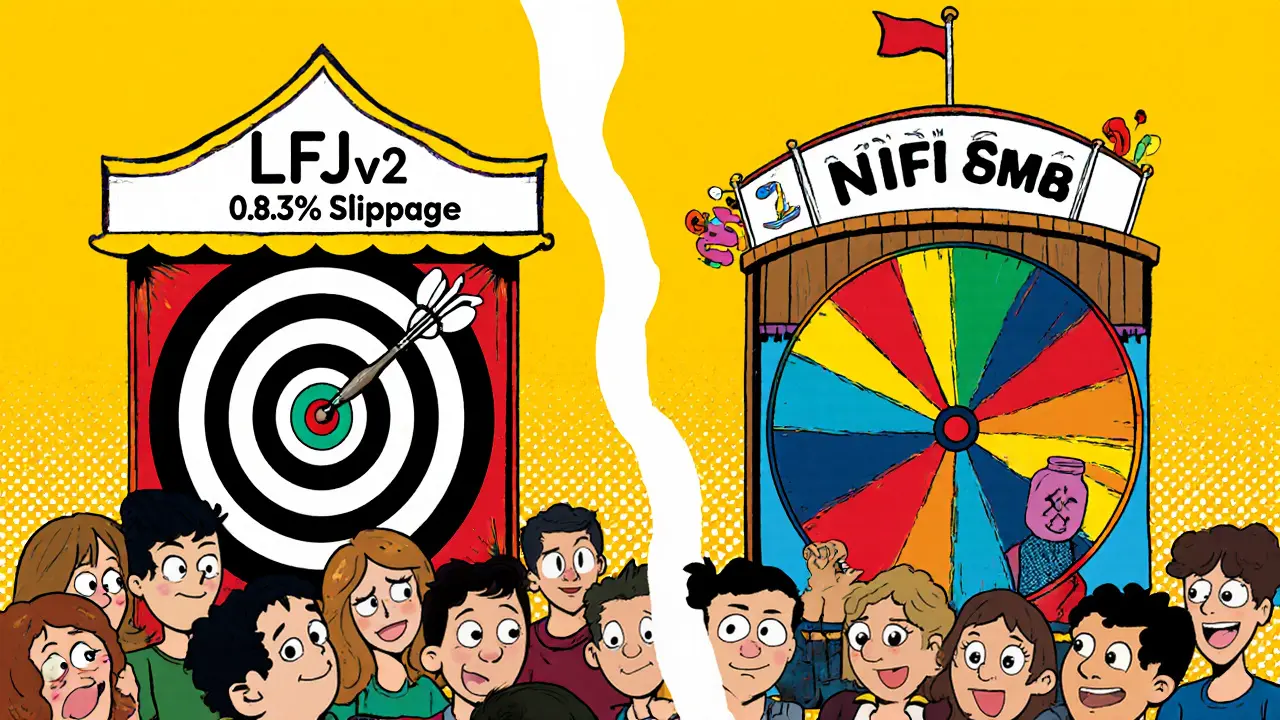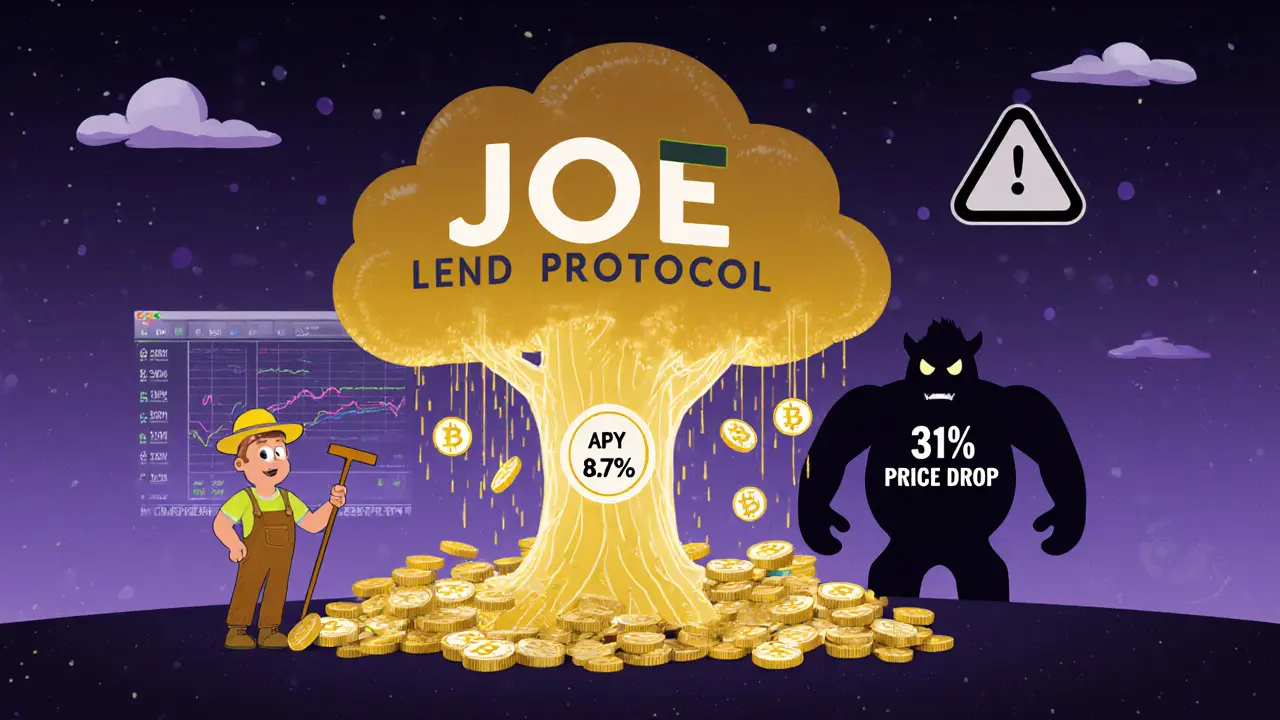
- 3 Nov 2025
- Elara Crowthorne
- 1
LFJ v2 (BSC) Swap Fee Calculator
Calculate Your Trade Costs on LFJ v2 (BSC)
Estimate exact fees for your BSC swaps based on current rates. See how LFJ v2 compares to PancakeSwap.
Trade Estimate
LFJ v2 vs. PancakeSwap
When you're trading crypto on BNB Smart Chain, you don't need a centralized exchange to swap tokens. You just need a reliable decentralized exchange - and LFJ v2 (BSC) is one of the top choices for experienced traders looking to cut fees and maximize yield. But is it right for you? This isn't a marketing page. This is a real breakdown of how LFJ v2 on BSC actually performs, what it does better than PancakeSwap, where it falls short, and who should avoid it entirely.
What Is LFJ v2 (BSC)?
LFJ v2 is the second version of Trader Joe, a decentralized exchange built for BNB Smart Chain (BSC). It launched its BSC-specific upgrade on September 14, 2023, and since then, it’s processed over 12,500 daily swaps. Unlike centralized platforms like Binance, LFJ v2 doesn’t hold your funds. You connect your wallet - MetaMask, Trust Wallet, or Ledger - and trade directly from it. There’s no KYC, no account creation, and no withdrawal delays.
The platform uses an Automated Market Maker (AMM) model with concentrated liquidity, the same tech Uniswap V3 pioneered. This means liquidity providers (LPs) can choose exact price ranges where their funds are active. It’s more efficient than older DEXs that spread funds across all prices. On BSC, this translates to tighter spreads and better rates for traders.
How Fees and Gas Costs Stack Up
On Ethereum, swapping tokens can cost $2-$5 in gas. On BSC, it’s different. LFJ v2 leverages BNB Smart Chain’s low fees, averaging just $0.05 per swap. That’s not a guess - it’s backed by GasNow data from October 2024.
LFJ v2 charges a flat 0.3% swap fee. Here’s how it breaks down:
- 0.25% goes to liquidity providers
- 0.05% goes to JOE token stakers
That’s standard for most DEXs. But here’s the twist: if you’re trading JOE-WBNB pairs with limit orders, the fee drops to 0.15%. That’s a direct incentive from Trader Joe’s governance to boost liquidity in its native token. If you’re actively trading JOE, this saves real money.
Gas fees stay low unless BSC gets congested. During peak hours, you might see spikes to $0.20-$0.30. That’s still 10x cheaper than Ethereum. Use BscScan’s gas tracker to time your swaps if you’re sensitive to cost.
Trading Pairs and Liquidity Depth
LFJ v2 on BSC supports 87 trading pairs. The top five by volume (as of October 1, 2024) are:
- JOE-WBNB - $1.24M daily
- USDC-USDT - $987K
- JOE-USDC - $762K
- BTCB-BNB - $643K
- ETH-BNB - $589K
That’s solid for blue-chip and stablecoin pairs. If you’re swapping BTCB, ETH, or USDC, you’ll get tight spreads and fast execution. Average slippage is 0.87% - better than PancakeSwap’s 0.98%.
But here’s the catch: micro-cap tokens are a gamble. Pairs under $50,000 daily volume show 3.2% average slippage. That’s nearly 50% worse than PancakeSwap’s 2.1%. If you’re trying to trade obscure tokens, you’ll get ripped off. Stick to the top 20 pairs unless you’re comfortable with high slippage.
How It Compares to PancakeSwap and ApeSwap
Let’s be honest - PancakeSwap dominates BSC with 58.7% market share. So why use LFJ v2?
Here’s the breakdown:
| Feature | LFJ v2 (BSC) | PancakeSwap V3 | ApeSwap |
|---|---|---|---|
| Average Slippage | 0.87% | 0.98% | 1.12% |
| Unique LPs | 1,842 | 2,917 | 1,678 |
| Stablecoin Capital Efficiency | 22% higher | Baseline | Lower |
| Leveraged Trading | No | No | Yes |
| NFT Marketplace | Basic | Full-featured | Basic |
| Cross-chain Bridge | Integrated (7 chains) | Only BSC | Yes |
| UI for Beginners | Complex | Simple | Moderate |
LFJ v2 wins on capital efficiency and slippage. PancakeSwap wins on user experience and gamified features like lotteries and NFTs. ApeSwap gives you leverage but worse liquidity.
If you’re a yield farmer who cares about getting the best rate on USDC-WBNB, LFJ v2 is better. If you’re a casual trader who wants to click and swap without reading a manual, stick with PancakeSwap.

JOE Token and Rewards
LFJ v2’s native token, JOE, isn’t just a governance token - it’s a yield engine. Every time someone swaps on the platform, 0.05% of the fee goes to JOE stakers. As of October 2024, staking JOE on BSC yields an average 8.7% APY in JOE tokens alone.
That’s higher than most stablecoin pools on other DEXs. And if you stake JOE in the JOE Lend protocol - Trader Joe’s built-in lending platform - you can earn even more. JOE Lend on BSC has a 14.2% utilization rate, meaning it’s actively lending out funds and generating fees.
But here’s the catch: JOE’s price is volatile. If you stake it for yield, you’re exposed to token depreciation. In Q3 2024, JOE dropped 31% over 60 days. So while the APY looks great, your overall return depends on price action.
Security and Audits
LFJ v2’s smart contracts were audited by OpenZeppelin in August 2023 (report #OZ-2023-087). That’s a good sign. The code is also time-locked - meaning upgrades can’t happen instantly. There’s a 48-hour delay, giving users time to react if something goes wrong.
They also run a bug bounty program via Immunefi, offering up to $100,000 for critical vulnerabilities. That’s more than most BSC DEXs offer.
But CertiK gave LFJ v2 a B+ rating in their 2024 DeFi Security Report. Why not A? Because it lacks circuit breakers. If Chainlink oracles go down (which has happened on other chains), the system doesn’t pause trading. That’s a risk during extreme market swings.
Who Should Use LFJ v2 (BSC)?
LFJ v2 isn’t for everyone. Here’s who it’s built for:
- Intermediate to advanced DeFi users - You know what slippage is, you’ve used a wallet before, and you understand liquidity provision.
- Yield farmers - If you’re stacking JOE and want the best APY on stablecoin pairs, this is one of the top spots.
- Traders who hate high fees - If you’re tired of paying $2 in gas on Ethereum, BSC + LFJ v2 is your sweet spot.
Who should avoid it?
- Beginners - The interface is cluttered. Concentrated liquidity isn’t intuitive. Only 28% of users rate the UI as “intuitive” (per Messari’s survey).
- Micro-cap traders - Avoid obscure tokens. Slippage will eat your profits.
- People who want NFTs or leverage - PancakeSwap and Biswap do that better.

How to Get Started (Step-by-Step)
Setting up LFJ v2 on BSC takes 15-20 minutes. Here’s how:
- Install MetaMask (recommended) or Trust Wallet.
- Add BSC Mainnet to your wallet:
Network Name: BSC Mainnet
New RPC URL: https://bsc-dataseed.binance.org/
Chain ID: 56
Symbol: BNB
Block Explorer URL: https://bscscan.com - Buy some BNB for gas - at least $5 worth.
- Go to joe.exchange and connect your wallet.
- Approve JOE or other tokens if you’re swapping.
- Click “Trade” to swap, or “Liquidity” to add funds.
For concentrated liquidity: click “Create Position,” then drag the price range slider. Don’t set it too wide - that defeats the purpose. Aim for a range where you think the price will stay for the next 2-4 weeks.
Common Problems and Fixes
Users run into a few recurring issues:
- Failed transactions - Increase slippage tolerance to 0.8-1.2% for volatile pairs. 0.5% is too low.
- High gas fees - Check BscScan’s gas tracker. Wait 10 minutes if fees spike.
- Confusing interface - Use the “Simple Swap” mode if you’re new. Avoid “Concentrated Liquidity” until you’ve practiced.
- Routing failures - If you’re swapping a rare token and it fails, try a direct pair (e.g., USDC to BNB, then BNB to your target). Multi-hop routes break often.
Community support is decent. The official Discord has 24/7 English help with 8-minute average response time. Telegram has over 17,000 members, but BSC-specific questions sometimes get buried under Avalanche chatter.
The Bottom Line
LFJ v2 on BSC is a powerful tool - but only if you know how to use it. It’s not the easiest DEX, but it’s one of the most efficient. If you’re swapping BTCB, ETH, or stablecoins and want the best rates with the lowest fees, it’s hard to beat.
But if you’re just starting out, or you’re chasing meme coins, you’ll be frustrated. PancakeSwap is friendlier. Biswap gives you leverage. LFJ v2 is for those who want precision, not fun.
Its biggest weakness? Liquidity fragmentation. Only 18.7% of Trader Joe’s total liquidity is on BSC. Most is on Avalanche. That means if you’re trading JOE, you’re competing with traders on other chains - and that can hurt your execution.
Still, with the upcoming V2.3 upgrade (Q4 2024) promising 15-20% lower slippage and integration with Binance’s new BEP-600 standard, LFJ v2 is evolving. It’s not going away. It’s just not for everyone.
Is LFJ v2 on BSC safe to use?
Yes, but with caveats. The smart contracts were audited by OpenZeppelin, and upgrades are time-locked. However, there are no circuit breakers for oracle failures, which could be risky during extreme market volatility. Always use a hardware wallet like Ledger for large amounts, and never deposit more than you’re willing to lose.
Can I stake JOE tokens on LFJ v2?
Yes. You can stake JOE directly on the platform to earn a share of swap fees. As of October 2024, the average APY is 8.7% in JOE tokens. You can also stake in JOE Lend, Trader Joe’s lending protocol, for additional yield - but that comes with higher risk if borrowers default.
How does LFJ v2 compare to PancakeSwap?
LFJ v2 has better capital efficiency and lower slippage on major pairs, especially stablecoins. PancakeSwap has a simpler UI, more users, and features like lotteries and NFTs. If you care about rates and fees, go with LFJ. If you want ease and fun, stick with PancakeSwap.
Do I need to pay gas fees on LFJ v2?
Yes. All transactions on BSC require BNB for gas. But fees are low - typically $0.05 per swap. During network congestion, they can rise to $0.30. Always check BscScan’s gas tracker before trading.
What’s the minimum amount to trade on LFJ v2?
There’s no minimum. You can swap as little as $1 worth of tokens. But if you’re adding liquidity, most pools require at least $50-$100 to be worth the gas cost and effort. Small liquidity positions rarely earn meaningful returns.
Is LFJ v2 better than centralized exchanges?
For trading major tokens like BTCB, ETH, or USDC on BSC, yes - because you avoid KYC, have full control of your funds, and pay lower fees. But for buying crypto with fiat, trading derivatives, or using advanced order types, centralized exchanges like Binance still win. LFJ v2 is a tool for DeFi-native users, not beginners.

1 Comments
Okay, but why does everyone act like LFJ v2 is some revolutionary breakthrough? It’s just Trader Joe with a BSC label-same code, same bugs, same 0.3% fee. You’re not saving money-you’re just paying in BNB instead of ETH gas. And don’t get me started on the liquidity fragmentation… 18.7% on BSC?! That’s not a feature, it’s a red flag!!